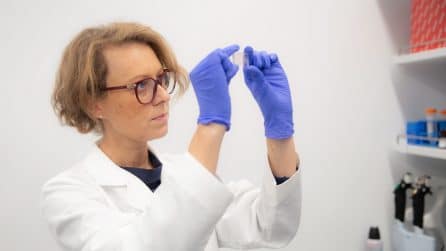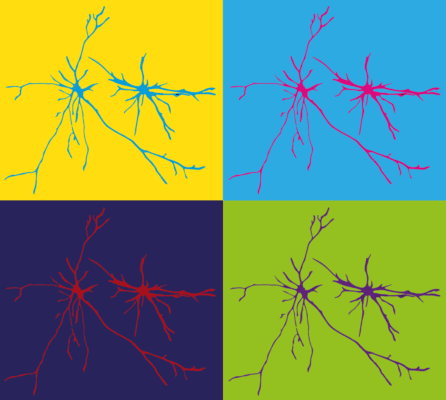How the ‘Stars of the Brain’ Could Protect Us From Neurodegeneration
NewsThe Context: Glia – the brain’s helper cells – are often overlooked in disease research, but are known to play both supportive roles for neurons, and to turn rogue and start killing them. We are still at the early stages of understanding how these cells develop, as well as how they could be driving (or protecting against) disease.
The Study: New research in Glia and Nature Neuroscience from the lab of Shane Liddelow, PhD, at NYU and including NYSCF scientists led by Valentina Fossati, PhD, helps unravel mysteries of these critical cells and why they may turn friend or foe when exposed to disease-related inflammation, as well as how they develop.
The Importance: This work advances our understanding of how glia take on key roles in the healthy brain and neurodegenerative diseases, as well as strategies for prompting them to defend (rather than attack) neurons.
Reining in a Rogue Cell
Previous work including NYSCF scientists led by Dr. Fossati have uncovered how astrocytes can ‘go rogue’ in diseases like Alzheimer’s or multiple sclerosis to attack the neurons they are meant to protect. These cells are called ‘reactive astrocytes,’ denoting their response to inflammation found in disease-affected brains. One of the team’s latest studies, first-authored by Priya Prakash, PhD, however, finds that in some cases, these reactions can also veer friendly.

“In our study, we further validated a new type of reactive astrocyte,” explained Dr. Fossati. “These cells were defined in previous work from the Liddelow lab, and are thought to have a protective role [rather than a toxic one] when they are exposed to certain proteins called interferons.”
“In our study, we showed that the presence of interferons profoundly impacts the state of reactive astrocytes which can be quantified by the changes in their protein expression,” added Dr. Prakash.
“Further, we show that some of these interferon-responsive proteins are also enriched in the brains of Alzheimer’s disease patients, opening up new avenues to study reactive astrocytes in diseased brains.”
Interferons are proteins secreted by many different types of cells, and can play roles in immunity. They could be present in the early stages of neurodegenerative disease, prompting astrocytes to put up defenses for their neuron friends.
“The proteomic profiling of astrocyte subtypes is particularly important because many neurodegenerative disorders are manifested at the protein level,” noted Dr. Prakash. “Proteins regulate almost all aspects of astrocyte state and functions, including the support and elimination of neuronal synapses and the regulation of the blood brain barrier.”
“It’s important that we understand astrocytes better, because we need to find ways to eliminate their toxic traits, but also, promote their protective ones,” said Dr. Fossati. “And that could help inform future therapies.”
Making Better Brain Cells
To capture how glia behave under different circumstances, we need effective models of studying them in the lab. Thanks to Dr. Fossati and others, we have made great progress in creating glia from stem cells, but there are still mysteries as to how these cells develop.
“At some point as these cells are maturing, something prompts them to say ‘become an astrocyte’ or ‘become an oligodendrocyte,’ noted Dr. Fossati. “We need a better understanding of how this happens if we want to find better ways to make these cells and study them.”

The team’s second study offers valuable knowledge to improve stem cell models of glia by aggregating information about the genetic switches that dictate what type of glia a stem cell will become.
“This is a resource paper that provides a large dataset detailing the genes involved in the development process for glia,” said Dr. Fossati. “The idea is that others can use this to make better glia in their own labs and study how they develop and behave.”
“Another important aspect of astrocyte development that remains unknown is whether there are species differences in their maturation,” added lead author Shane Liddelow, PhD. “This study helps to define these cross-species differences and ensures that we are able to map changes that may occur due to mutations associated with developmental disorders.”
Beyond this, knowing how to turn one cell type into another could have implications for disease treatments.
“Very long-term, once we know how to make these cells, it opens up new therapeutic options. For example, perhaps converting one cell type in the brain to another more protective one could be an option for treating neurodegeneration.”
Journal Articles:
Proteomic profiling of interferon-responsive reactive astrocytes in rodent and human
Priya Prakash, Hediye Erdjument-Bromage, Michael R. O’Dea, Christy N. Munson, David Labib, Valentina Fossati, Thomas A. Neubert, Shane A. Liddelow. Glia. 2023. DOI: https://doi.org/10.1002/glia.24494
Longitudinal scRNA-seq analysis in mouse and human informs optimization of rapid mouse astrocyte differentiation protocols
Paul W Frazel, David Labib, Theodore Fisher, Ran Brosh, Nicolette Pirianian, Anne Marchildon, Jef D Boeke, Valentina Fossati, Shane A Liddelow. Nature Neuroscience. 2023. DOI: https://doi.org/10.1038/s41593-023-01424-2

